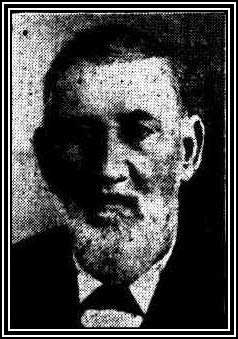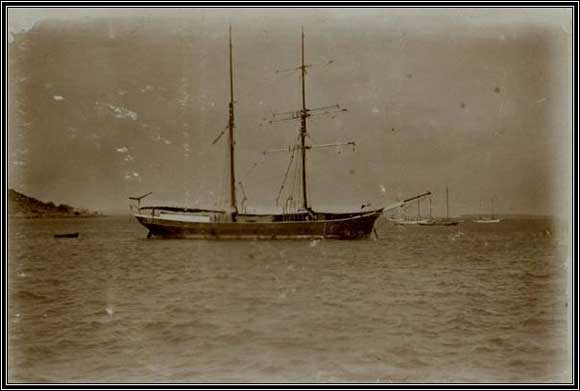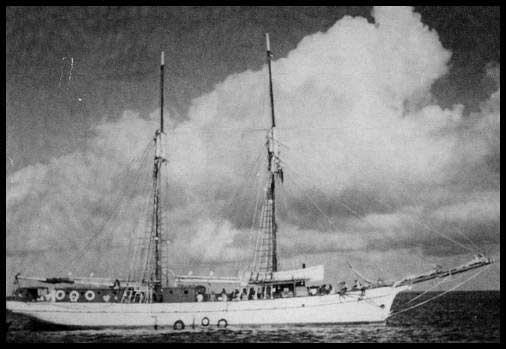The Lovely Schooner “Wanetta”
By Julien Durup, a student of history
The sailing vessel (S V) Wanetta was built in 1898 by David Drake, in Balmain, New South Wales, Australia. According to Lloyd’s Register ‘Navire a voiles’ 1930-1931 she was registered in Port Victoria, Mahé, Seychelles. In the Seychelles maritime annals we found mostly the sturdy Seychellois built ships that ended in Australia, but rarely the opposite. It is worth mentioning that the following three Seychellois-built ships ended their lives in Australia: The first one was the 95 ton square brig Arpenteur, built at Praslin in 1839. She was wrecked in a strong gale under the command of Captain William Owen at Cheynes Beach, Western Australia. The second was the 328 ton Marie Laure, built in 1840 at Marie Laure, Bel Ombre, Mahé; she was still in use in the late 1940s in Melbourne as a pontoon. The last one was the Josephine Loizeau, built at Mahé in 1841 and wrecked on the 10th of July 1856 at Port Eliot, in South Australia.
David Drake was born in Leith, near Edinburgh, in Scotland; there he worked under his father who was a shipbuilder. In 1861, at the tender age of 23 years old as a marine carpenter, it is alleged that he boarded at Liverpool, the Champion of the Seas, a beautiful clipper of the Black Ball Line heading for Sydney, Australia. Soon after his arrival he started work on the Glebe Island wooden bridge and became a foreman in Chowno’s shipbuilding yards in Pyrmont, in New South Wales. In 1866 he started to build many ships, with the first being the schooner Annie D, and followed by several more ships. He also built many large wooden ferry steamers, the last being the Bald Rock. She was later renamed Vaucluse and used as a tug and then later converted into a lighter (barge). David Drake died on Friday the18th of August 1922 at the ripe old age of 84 years old.

David Drake
Photo: the Sydney Morning Herald 18 August 1922
The Wanetta was a121.8-ton, 2 masted topsail schooner, elliptical stern, billet head, carvel wood construction of 101 feet and 6 inches long, and a beam of 24 feet and 4 inches wide. She was first registered in Sydney on the 23rd of September 1898 and her first owner was James Clark, a pearl dealer and pastoralist of “Mascotte” New Farm Road, Brisbane, Queensland. Clark was a very heavy cigar smoker who was better known as the “Pearl King”. After the great cyclone of 1899, he financially lost a lot but soon swiftly recovered his fortunes. He became dissatisfied with the new Federal Immigration Restriction Act of 1901. And in 1905 he took 115 of his boats, including the Wanetta, from Thursday Island to the Dutch-owned Aru Islands where he received a concession and formed the Celebes Trading Company in 1904 with his partner S E Munro. In 1904 Clark was appointed Consul for the Netherlands in Queensland.
On the 13th of March 1906 he sold the Wanetta to a Dutch Company in the Aru Islands, and 8 years later the Dutch Company sold her to Reginald Augustus Charles Hockings, a pearl seller, of Thursday Island, and the Wanetta was re-registered in Sydney on the 6th of May1914. She was again sold on the 1st of May 1919 to two other pearl dealers, Vincent Jessup and Ernest Naylor, both of Broome, Western Australia. On the 1st of December 1919 the two pearl dealers sold her to a Joseph Rudolphe Closel, a merchant of Port Louis, Mauritius. The Wanetta sailed to Mauritius and was first registered there on the 28th of January 1920.

SV Wanetta 1905
In1930, according Lloyd’s Register,the Wanetta was in the Seychelles and registered in Port Victoria, Mahé, to Captain Felix Georges Joseph Lanier and Percival V Hunt, as Amateur. However, the Wanetta was in service in 1925 in the Seychelles for the same company that had not insured her with any insurance company. The way Captain Georges Lanier acquired the Wanetta was a bit dubious. It was said, according to oral traditions, that the Wanetta was found adrift, much like the (brigantine Merchant ship Marie Céleste as mentioned by Sir Arthur Canon Doyle), a ghost ship, near one of the Seychelles outlying Islands. She was still in a seaworthy condition and was taken to Mahé by Captain Georges Lanier. At Mahé a certain Captain G C Jouanis, a partner of Lanier, certified that the Wanetta was a wreck beyond repair and the port authorities informed the owner so. Later, her former owner in Mauritius wanted to take legal action and Lanier coyly decided not to send her to Mauritius. On the 17th of September 1925 she made her first trip to Nossi Be, Madagascar, under the command of Lanier, where she continued on her regular journey firstly, to Madagascar then on to Beira, Mombasa, and other Islands in the Seychelles until 1948 when she underwent a major repair and had a new engine installed. She could now carry more cargo and became the most beautiful vessel in the Seychelles. She was then registered as Auxiliary Motor Vessel, (A M V) Wanetta. She was the last schooner with double square topsails in the Seychelles. She left the Seychelles on 26th of November 1950 under the command of Captain Paul de Lafontaine for her last long journey (as the Wanetta) to Mombasa and other outlying islands including Farquhar. On the 20th of December 1950 she was wrecked ashore during a tropical cyclone on Farquhar Island. She had major repairs on the Farquhar Island, and when she was re launched she was renamed the Revenant, on the 6th of November 1951.She was later referred to by the locals as Le Revenant and Revenant Farquhar. On the 14 of November 1951 she left the Seychelles under the command of Captain Joseph William Celtel for Madagascar as AMV Revenant. When she was wrecked her owner had been Dr Paul Edouard Maxime Lanier. The same Dr Lanier,

AMV Revenant 1959
Photo: Captain Jean Sauvage.
a young medical officer, who later became the Chief Medical Officer of the Seychelles. Lanier resigned in 1924 and went to Switzerland to further his studies in Lausanne, where his wrote his final well known thesis (Envenimation et hypogliciéme) in 1928. He came back and worked in the Seychelles, and later left the Seychelles to retire in Lausanne where he died. Dr Lanier was married to a rich lady from Mauritius and they had one son and one daughter. Before his departure he sold all his properties, including, Farquhar Island to Mr Paul Moulinie, who had been his driver and who had to pay Lanier back by instalments. During the cyclone the Wanetta was in the harbour at Farquhar Island under the command of Captain Delafontaine. He decided to keep her in the harbour with additional anchors; the hurricane was powerful enough to drag the Wanetta up above the high-water mark. During that time there had been another boat called the Charles Edward (named after Captain Charles Jouanis and Edward Lanier) from Mahé en route for Farquhar. (The Charles Edward was built at Praslin in 1930 by Captain G C Jouanis and Eugene Vidot, and was later burned by accident in Mahé). The captain of the Charles Edward tried to avoid the storm by sailing north. They encountered heavy seas and three days later, while approaching Farquhar, they located the Wanetta which they had thought she was safely anchored in the harbour. Paul Moulinie who was on board praised Captain Delafontaine for his fine insight. When they approached the harbour they saw to their dismay that Wanetta was in fact on terra firma. All the crew had remained on board the Wanetta butsadly we do not have all their names. However, we know of four of them; one being Mr Esmé Jumeau, a mechanic who later turned politician and became minister in Rene’s government, and a certain Mr Clement Delpech, also a mechanic with his son Clet who became a policeman and later went to South Africa. The forth name was Nile Durup.
Arriving ashore, Paul Moulinie was shocked to see the major devastation; most of the coconut and other trees had been uprooted. After his inspection it is alleged that he told Mr Price René, the manager of the island, to repair the damaged infrastructure and begin the replanting of coconuts and promised him a huge recompense. When it was all done, René did not receive any compensation. Interestingly in his correspondences René, always referred to the island as Juan de Nova (the former name of Farquhar Island). The island used to have two harvests of maize per year and the 147-ton schooner Revenant usedtoleave the island fully loaded with maize for Mauritius.
Captain Jean Sauvage, a former well known Port Officer, began his seamanship on the Wanetta. Captain Joseph William Celtel served on the Revenant and he also trained many Seychellois mariners. Captain Guy Adam of SEYPEC also served his seamanship on the Revenant. Another Seychellois Captain, Julien Joseph Robertson Durup, better known as Berty and his twin brother Jules Robert Durup served on the Wanetta under Captain Georges Lanier. They also served under Captain Raymond Parcou, the Seychelles only Extra Master Mariner. Raymond became Captain in Mauritius on 14th of February 1903 and passed his Extra Examination in Sydney, Australia, on 4th September 1943. Robert later died in Bombay and was buried in the Swri Christian Cemetery in Bombay (Mumbai). Berty later became Captain and was based mostly in Mauritius. During the Second World War his main route was Port Louis to Hong Kong and vice versa.
Coxswain Japhet Grandcourt was also a novice on the Wanetta, however, he started his seamanship under Captain Thomas on the three masted Diolinda (formerly the Annie Reece), built in 1909 in Appledore in the North of Devon, England. She was the first vessel in the Seychelles that had an engine.
The Revenant was broken up in 1962 after 64 years’ service in Australia, Mauritius, and the Seychelles. Then her 160 horse powered Blackstone diesel engine was transferred to the 176-ton Isle of Farquhar. The latter was the last three-masted steel schooner in the Seychelles. She was built in Gröningen, Holland in 1909 and was known as R W Jönsson, Liunea, Kyllikki, Zeemeeux, La Perle and finally Isle of Farquhar.
It is worth noting that Captain Delafontaine was involved in another interesting event, and this time it was during the untold ‘mutiny on the Isle of Farquhar’ against Captain Edward Hoareau alias tig (tiger). Captain Delafontaine who was then First Mate took command in a cyclone and safely sailed the Isle of Farquhar to Mauritius. The mutiny was instigated by the crew and passengers as they locked tig in his cabin after his many failed attempts to enter the harbour of Port Louis. Among the initiators was Philippe Boullé, and another interesting passenger was Pastor Caleb Bru who was constantly reading his Bible and did not take part in the mutiny.
The last few voyages of Isle of Farquhar remind us of the famous saying of Desiderius Erasmus “In the kingdom of the blind, the one-eyed man is king”because tig was nearly blind and Delafontaine had Parkinson disease. En route tig would hold the sextant while Delafontaine looked through it.
Ref:
- Ex. info’s: Jeffrey Durup, Robert Grandcourt, Philippe Boullé, Captain Guy Adam, Norm Morgan and Guy Savy.
- P A B Thomson: Seychelles Schooners: A Retrospect. The Mariner’s Mirror Vol. 84 No.3 (August 1998), pp.316-321
- Patricia Mercer: James Clark 1877-1933. Australian Dictionary of Biography.
- Plimsoll Ship Data: The Lloyds Register.
- Shipping register: Seychelles National Archives.
- The Ron Persons’ List: Encyclopaedia of Australian shipwrecks.
- The Sydney Morning Herald 18 August 1922.


